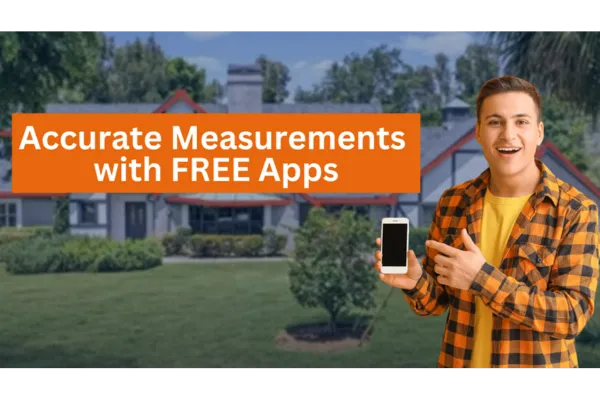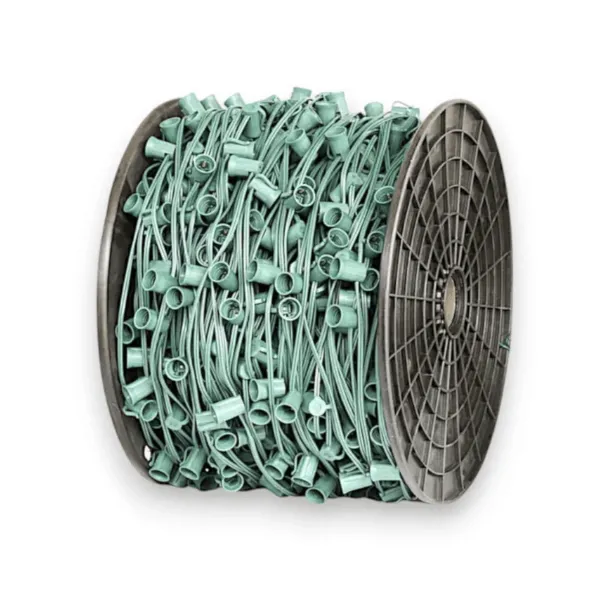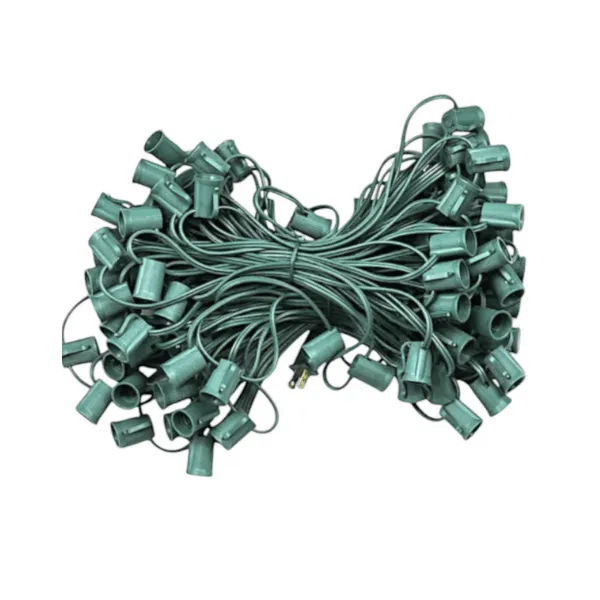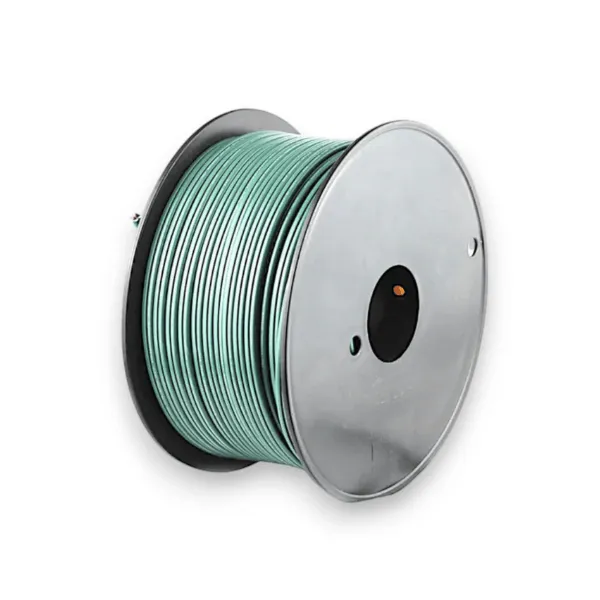Wholesale Pricing Presale Christmas Lights Socket Wire Spools, Stringers & Zip Cord
Pre-Season C9 1000' Socket Wire Spools
Looking for the cheapest Christmas lights wire spools at wholesale pricing?
Achieve perfect customization for any holiday display with our 1000-foot spool of customizable wire, available in Green, White, Brown, and Black. This versatile wire lets you cut precise lengths to ensure a flawless fit for every project. With flexible spacing options of 12", 15", 18", 24", and 36", you can tailor installations to meet specific needs. Available in top brands like Commercial, Minleon, and Admiral, this SPT-2 wire is the ultimate choice for professional-grade installations.
Key Features:
1000 Feet of Customizable Length: A full spool of 1000 feet provides ample wire to customize and cut to the exact lengths required for your installation, ensuring a perfect fit for every project.
Flexible Spacing Options (6" to 48")
12-15" Spacing: Ideal for residential roofline installations, providing a balanced and visually appealing light distribution.
24-36" Spacing: Perfect for tree installations, allowing you to place larger C9 bulbs strategically within the branches. The wider spacing helps to avoid a straight-line effect, creating a more natural and staggered look.
Pre-Season C9 Green Stringers SPT-1
Illuminate your home, business, or event with the highest quality Holiday Light String. Designed for both residential and commercial decorators, these light strings are made from top-tier 18-gauge UV-protected wire, ensuring years of maintenance-free use. Perfect for any season, these light strings are compatible with both incandescent C9 and LED C9 bulbs, offering versatility and long-lasting performance.
Key Features:
Professional-Grade Sockets: Equipped with durable sockets that feature weep holes, these light strings are engineered for trouble-free performance even in damp weather conditions.
SPT-1 Insulation: Boasting a 5 Amp capacity, the SPT-1 insulation ensures safe and reliable operation, making these strings ideal for both indoor and outdoor use.
End-to-End Connectivity: Each string comes with a male and female plug, allowing for easy end-to-end connections to extend your lighting display effortlessly.
Pre-Season C7 1000' Socket Wire Spools
This C7 1000' Bulk Spool of Socket Wire is designed with the professional installer in mind, offering exceptional flexibility and durability for a wide range of lighting projects. Whether you’re enhancing residential rooflines or creating stunning tree displays, this spool is crafted to meet the demands of any installation, providing the perfect solution for custom lighting designs.
Key Features:
Durable SPT-1 Wire: Built to endure harsh outdoor conditions, this heavy-duty wire ensures that your lighting installation remains secure and reliable season after season.
Compatible with C7 Bulbs: Specifically designed for C7 bulbs, whether you choose traditional incandescent or energy-efficient LED options, offering versatility in your lighting setups.
Pre-Season Christmas Lights Zip Lamp Cord SPT-1 or SPT-2
As Low As $0.19 per foot
Take full control of your lighting installations with our Spools of Lamp Cord SPT-1 Extension Wire (Zip Cord). Ideal for professional and DIY decorators alike, this versatile extension wire allows you to create custom extension cords, add jumper wires, or extend your C9 or C7 stringers with ease. Whether you’re enhancing rooflines or adding length to your holiday displays, this spool provides the flexibility and durability needed for both indoor and outdoor applications.
Key Features:
250' - 1000' of SPT-1 Extension Wire: A full spool gives you ample wire to customize your lighting installations, ensuring you have the exact length you need for any project.
Zip Cord Design: The 18-gauge, 2-conductor wire is easy to work with and perfect for creating custom extension cords or adding extension leads and jumper wires to your lighting setup.
8 Amps/960 Watts Rating: The SPT-1 wire is rated for 8 amps or 960 watts, providing reliable performance for both small and large-scale installations.
Indoor and Outdoor Use: Designed to withstand various conditions, this wire is suitable for both indoor and outdoor use, making it a versatile addition to your lighting toolkit.
Perfect for C9 or C7 Stringers: Use this extension wire with our spools of SPT-1 male and female plugs to customize your C9 or C7 light stringers, ensuring a seamless and professional-looking display.
Frequently Asked Questions
What lengths are available for the Christmas lights wire spools?
The wire spools are available in customizable lengths of up to 1000 feet, ensuring you have enough wire for any size installation.
What spacing options are offered for the sockets?
The spacing options include 12", 15", 18", 24", and 36", allowing you to tailor your lighting design to specific project needs.
What colors are the wires available in?
The wire is available in Green, White, Brown, and Black, offering flexibility to match your design and installation requirements.
Are these wires compatible with both C9 and C7 bulbs?
Yes, the wires are compatible with both C9 and C7 bulbs, making them versatile for various holiday lighting setups.
What makes these sockets durable for outdoor use?
The professional-grade sockets feature UV protection and weep holes to prevent moisture buildup, ensuring reliable performance in outdoor conditions.
Are the wires safe for outdoor installations?
Absolutely! The wires come with SPT-1 insulation and a 5 Amp capacity, ensuring safe and reliable operation for both indoor and outdoor use.4o
Discover Expert Tips on Our Blog

House Measurement Techniques for Accurate Bidding
When it comes to construction, renovation, or holiday decoration projects, accurate measurements are crucial. One wrong calculation can significantly impact your budget and timeline. Today, we'll explore three powerful free tools that help you measure buildings accurately from photos, ensuring your estimates are spot-on every time.
Why Accurate Measurements Matter
Consider this scenario: if you estimate a project at 140 feet when it's actually 200 feet, your cost calculations could be dramatically off. What started as $4 per foot might suddenly become $1 per foot, severely impacting your profit margins or project budget. This is why having reliable measuring techniques is essential for any contractor or DIY enthusiast.
Tool #1: ELEIF - The Professional's Choice
Measure in photo online ‐ eleif.net
ELEIF is a time-tested online measurement tool that offers precise calculations from photographs. Here's how to use it:
1. Upload your photo by dragging it into the interface
2. Set your reference measurement (typically a door width of 3 feet)
3. Use the measurement tool to mark key points along your structure
4. Record and add up all measurements
5. Add a 10% buffer for accuracy

Pro Tip: When measuring complex structures, always account for architectural features that might not be immediately visible in the photo, such as door overhangs or roof extensions.
Tool #2: Image Measurement
This user-friendly tool offers enhanced zoom capabilities for more precise measurements:
1. Import your photo
2. Use the zoom function to get a clearer view
3. Set your reference point (again, using a door or known object)
4. Take measurements by clicking points along the structure
5. Calculate total measurements
6. Compare results with other tools for accuracy

Tool #3: Canva - The Creative Solution
While primarily known for design work, Canva offers a surprisingly effective measurement solution:
1. Upload your photo to a YouTube thumbnail template
2. Use the ruler element tool
3. Set your reference measurement (3 feet for a standard door)
4. Duplicate and rotate the ruler to measure different sections
5. Track your measurements in increments (10 feet, 20 feet, etc.)

Best Practices for Digital Measuring
1. Use Known Reference Points
- Standard door width (3 feet)
- Garage doors (8 feet for single, 16 feet for double)
- Windows or other standard architectural features
2. Always Add a Buffer
- Include a 10% margin for error
- Account for hidden features not visible in photos
- Better to overestimate slightly than underestimate
3. Cross-Reference Your Results
- Use multiple tools to verify measurements
- Compare results between different methods
- Look for consistency in measurements
Common Pitfalls to Avoid
- Don't forget to account for:
- Door overhangs
- Architectural protrusions
- Roof extensions
- Corner details
- Changes in elevation
When to Use Which Tool
- ELEIF: Best for straight-line measurements and simple structures
- Image Measurement: Ideal for detailed work requiring zoom capability
- Canva: Perfect for quick estimates and visual reference points
Final Tips
1. Always verify your reference measurements
2. Take multiple measurements when possible
3. Document your process for consistency
4. Consider seasonal changes or structural variations
5. Keep records of your measurements for future reference
Remember, the goal isn't just to get a number – it's to get an accurate measurement that you can confidently use for project planning and execution. Whether you're a professional contractor or a DIY enthusiast, these tools can help you achieve precise measurements without stepping foot on the property.
Want to learn more about construction measurements and professional techniques? Visit ChristmasLights.io for additional resources and tips from industry experts.

Q: Why should I use multiple apps to measure the same building?
A: Using multiple measurement tools helps verify your calculations and ensures accuracy. Each tool has its own strengths - for example, Image Measurement offers better zoom capabilities, while Canva provides easy-to-duplicate measurement units. By cross-referencing results between different apps, you can catch potential errors and arrive at the most accurate measurement.
Q: What's the best reference point to use when measuring from a photo?
A: The most reliable reference points are standardized building features:
- A standard door (3 feet wide)
- A garage door (8 feet for single, 16 feet for double)
- Standard windows
Always try to use the garage door as your first choice since it provides a larger reference point, which can lead to more accurate measurements across the entire structure.
Q: Why should I add 10% to my measurements?
A: Adding 10% serves as a safety buffer for several reasons:
- Accounts for hidden architectural features not visible in photos
- Compensates for potential measurement errors
- Covers unexpected protrusions or overhangs
- Ensures you have enough materials for the project
It's better to slightly overestimate than to run short on materials or underquote a project.
Q: Can these tools replace physical measurements?
A: While these digital tools are extremely helpful for initial estimates and remote measurements, they work best as complementary tools to physical measurements. For final, detailed work, it's still recommended to take physical measurements when possible. However, these apps are excellent for:
- Initial project estimates
- Remote quotes
- Preliminary planning
- Situations where physical access isn't immediately possible
Q: What can cause inaccurate measurements when using these apps?
A: Several factors can affect measurement accuracy:
- Using an incorrect reference point size
- Not accounting for perspective in photos
- Overlooking architectural features like overhangs
- Poor photo quality or angle
- Not considering depth in protruding features
To minimize errors, always use clear photos taken straight-on, verify your reference measurements, and cross-check results between different tools.

Q: Are these tools really free to use?
A: Yes, all three tools mentioned (ELEIF, Image Measurement, and Canva) offer free versions that include their measurement capabilities. While Canva does have a premium version, the measurement features discussed are available in the free version.
Q: How do I handle complex architectural features like bay windows or irregular shapes?
A: For complex features:
1. Break down the measurement into smaller, manageable sections
2. Measure each section individually
3. Account for depth and protrusions
4. Add extra buffer for irregular shapes
5. Consider taking multiple photos from different angles to better understand the structure
Q: What's the best way to document measurements for future reference?
A: Best practices for measurement documentation include:
- Take screenshots your measurements in each app
- Create a spreadsheet with all measurements and calculations
- Note which reference points were used
- Record the date and conditions of measurement
- Save the original photos used for measuring
- Document any assumptions or special considerations made
Q: How accurate are these digital measuring tools?
A: When used correctly with proper reference points and clear photos, these tools can be accurate within 5-10% of physical measurements. However, accuracy depends on:
- Quality and angle of the reference photo
- Accuracy of the reference point measurement
- Complexity of the structure
- User expertise in using the tools
This is why using multiple tools and adding a 10% buffer is recommended for professional estimates.

Have more questions about digital measuring techniques? Visit ChristmasLights.io for additional resources and expert guidance.
Copyright ©2025 All Right Reserved website designed by christmaslights.io
Terms of Service / Privacy Policy
Have questions or need assistance?
Contact us at (855)619-LITE






